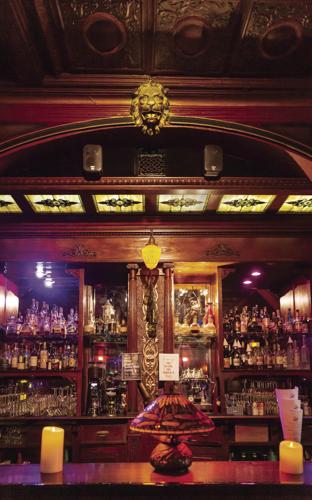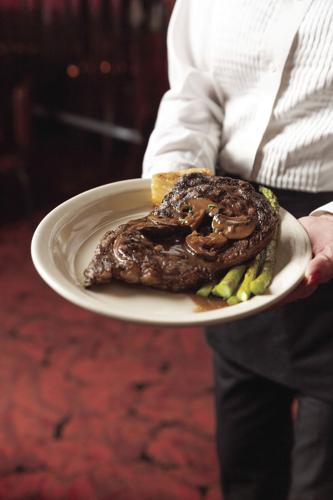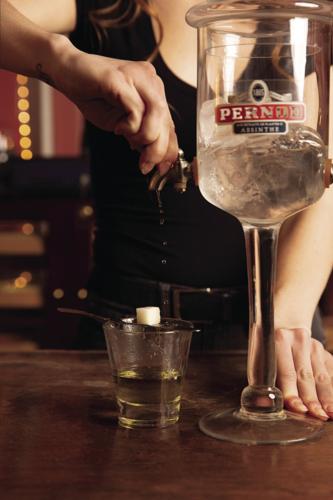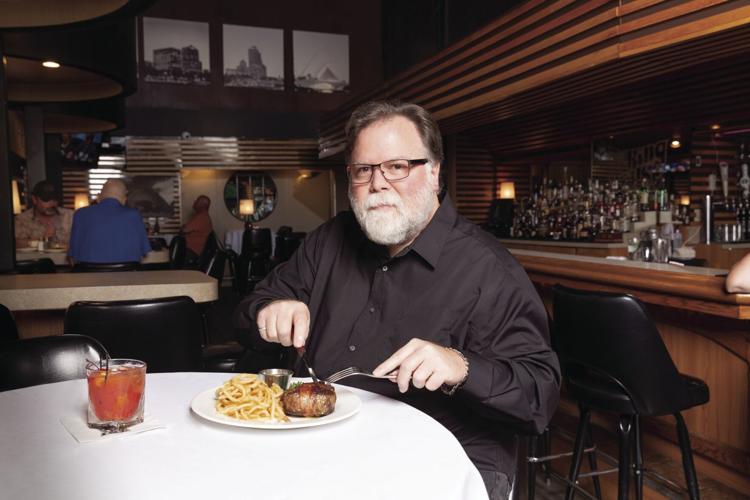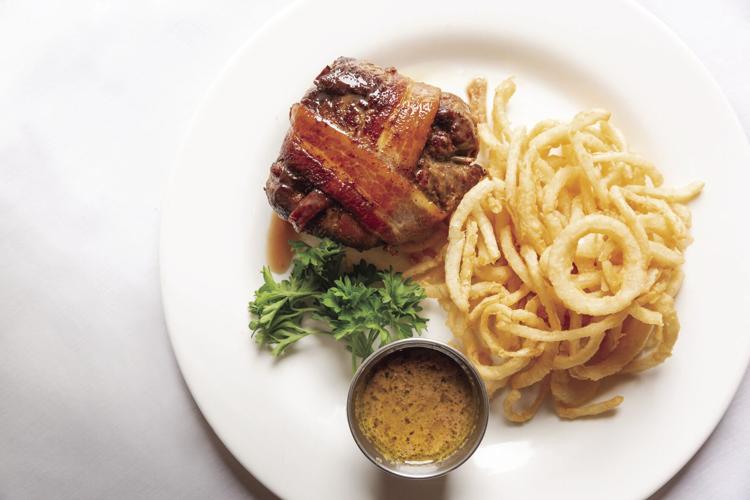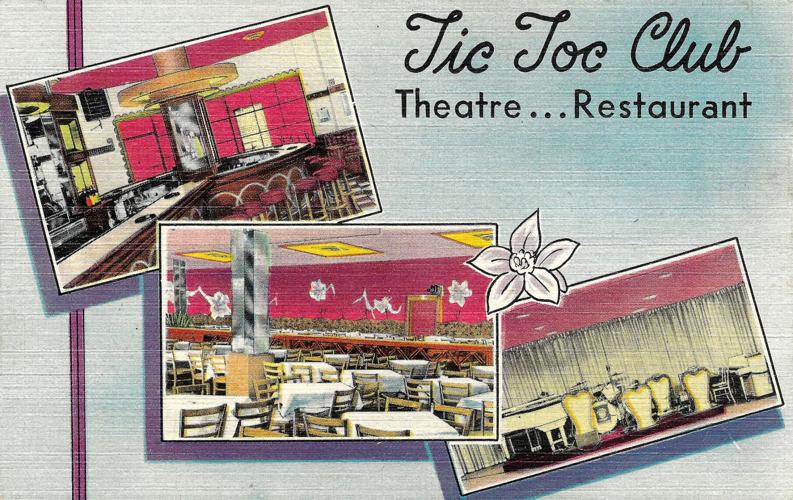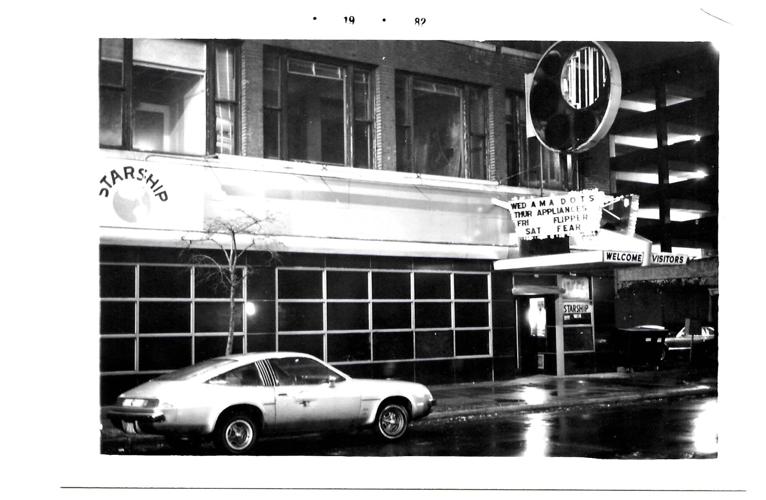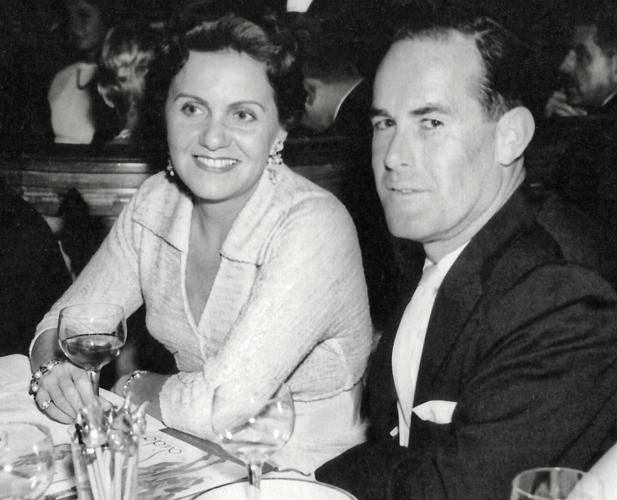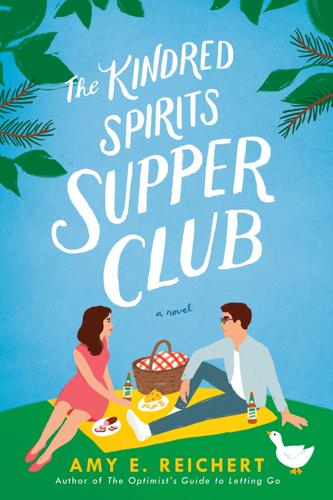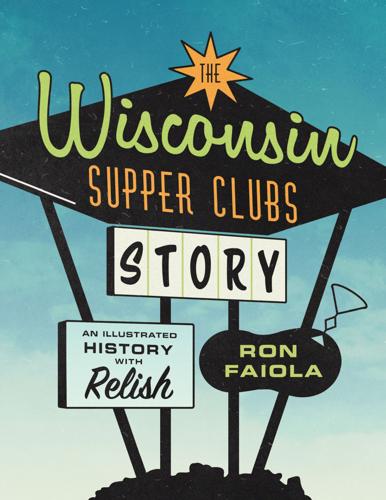
Author Ron Faiola at The Packing House supper club.
Really, what’s not to like about a supper club? The ambience is comforting, the food is usually amazing, and for many, it’s the ideal gathering spot to catch up with family and friends. Most are packed Friday and Saturday nights for fish fries and prime rib nights. And from aperitifs to specialty cocktails and after-dinner drinks, there’s something soothing about a facility that knows your personal liquor preferences.

Ron Faiola’s new book, “The Wisconsin Supper Clubs Story: An Illustrated History, With Relish” (Agate, 2021) celebrates the dining experience. The third installment in his “Wisconsin Supper Clubs” series focuses on the century-old background of the unique eatery experience.
Faiola grew up going to supper clubs and became a student of their history. “One thing that I really wanted to clear up was the legend that the first supper club was started in the 1920s in Beverly Hills by Milwaukee native Lawrence Frank,” he says. “The first chapter of ‘The Wisconsin Supper Clubs Story’ explains how that tale got started, and the rest of the book refutes that theory.”
Over the years, Faiola’s research included driving thousands of miles to visit more than 100 supper clubs. “I’d estimate I’ve been to nearly 150 clubs in my lifetime,” he says. “The only one I know who’s been to more supper clubs in Wisconsin is Al Capone, because every club has an ‘Al was here’ story. However, I address that legend in ‘The Wisconsin Supper Clubs Story’ — Al was a bit too busy selling bootleg whiskey in Chicago to spend much time here.”
We caught up with Faiola to talk clubbing (of the supper variety).

Starship Supper Club 1992 exterior.

Shaker’s Cigar Bar
MKE Lifestyle: What are the “requirements” of a supper club compared to other restaurants — ambience, service, menus, drinks?
Ron Faiola: Supper clubs generally have what I call the “holy trinity” of decor: twinkly lights, dark wood paneling and some taxidermy on the walls. Having “supper club” in their name helps, but at the very least they should be family-owned and -run, with the family often living on the premises. Food is made from scratch, the brandy old-fashioneds are hand-muddled, and the menu is simple: steaks, chops, seafood and fish fry on Friday, prime rib on Saturday and chicken and ribs on Sunday. Relish trays are important, but not all the clubs serve them any more — too many people weren’t eating them!
One of the main things that defines a supper club is its unusual hours, or that it’s only open on weekends, or it shuts down for a week with a “Gone Hunting” sign on the door. In addition, there are more than a few that close for the winter months. Finally, I always remind people that not all the supper clubs take credit cards. It’s important to check the details before traveling.
How have supper clubs changed over the years?
What’s been their contribution to the Milwaukee area entertainment scene?
Live entertainment isn’t such a big thing anymore. There are some places that still have some live jazz or a piano player, but dancing — which was a big draw for supper clubs in the past — has disappeared.
Back in the ’40s, ’50s and ’60s, The Tic Toc Club and Fazio’s on Fifth (both at 634 N. 5th St.) featured up-and-coming entertainers on their stage, including Joey Bishop, Henny Youngman, Martha Raye, Patti Page and an appearance by a very young and pre-controversial Lenny Bruce. That same location later housed a punk rock club called Starship and also featured new bands like Black Flag, The Cramps, X, and Captain Beefheart, plus local acts including the Violent Femmes, XCleavers, Die Kreuzen and my own band at the time, Couch Potatoes (later Couch Flambeau).
However, it was the Holiday House on Clybourn and Van Buren that brought in the A-list talent from 1949 to 1965, including Dean Martin, Tony Bennett, Phyllis Diller, Frankie Avalon and Lionel Hampton, plus Wisconsin-born entertainers Liberace, Hildegarde, Les Paul, Al Jarreau and Vaughn Monroe.
Sadly, both of those locations are now parking lots.
It seems that, prior to COVID, there was a several-year boom in supper club attendance. What’s the attraction?
In 2010, we were just coming out of the Great Recession and consumers were slowly getting back to dining out. I was filming my documentary, “Wisconsin Supper Clubs — An Old Fashioned Experience,” and the club owners didn’t have a very positive outlook toward the future. Supper clubs had been taken for granted for some time at that point. But after the film aired on PBS, there was this renewed enthusiasm and a nostalgia for these “restaurants of yesteryear.” Supper clubs were also recognized as a cherished Wisconsin tradition.
When my first two books were released, people actually took them on their supper club trips around the state. Club owners have told me how customers would bring their books in to be signed. The owners loved the attention (and the business). There were even Supper club clubs that were organized — groups of people who gathered at a different club on a regular basis. In addition, social media became a convenient place where people could share their experiences. So supper clubs didn’t change, they just became a sought-after destination again.
You cover the challenges supper clubs faced, including World Wars, pandemics and fast-food chains. How did they adapt to survive?
Really, the biggest threat to supper clubs are the corporate chain restaurants. They have national name recognition and the wherewithal to do what they want. Supper clubs have been in the same location for decades. For some, that used to be on the outskirts of town. Now they’re surrounded by big box stores and strip malls loaded with the all-too-common sight of the same old fast-food and fast-casual restaurants. If that location isn’t profitable, the chain has the flexibility to move to the latest suburban development. A supper club can’t do that.
That said, from what I’ve seen, the way the clubs have handled those challenges was to just continue to do what they do best — provide personal service, scratch-made food and great drinks. That’s what keeps customers coming back. They’re comfortable there and as regulars, they quickly become part of the supper club’s extended family.
What might the future for supper clubs look like after COVID is under control?

Shaker’s Cigar Bar
Nearly 15 years ago, most supper club owners managed to weather the Great Recession, when people cut back on dining out to save money. During 2020, people were supportive of supper clubs, even if it meant just getting take-out meals or buying gift cards to support a favorite one. As much as the pandemic was an unimaginable disruption for the owners, the strength of the supper club tradition helped bring customers back to the clubs — in droves, as it turned out, which became too much of a good thing this year.
Right now, the issues that the clubs are facing are coming from all sides — shortages of food and supplies, higher wholesale prices and a lack of staff. These challenges have caused supper clubs to limit their hours and even the number of days they’re open. It’s going to take some time to sort these issues out, and we may never really get back to pre-pandemic “normal” again. It’s not just COVID, but environmental issues, too. As customers, we’ll have to get used to paying more, having patience to wait longer for a table, and learning to accept the limited availability of popular menu items.
What are some of your favorite Milwaukee area supper club experiences and moments?
For me, the ultimate supper club experience is much like everyone else’s — relaxing with friends and family and enjoying some good food. I like sharing an appetizer like shrimp cocktail or something special, such as escargot or bacon-wrapped scallops. For an entrée, I’ll usually get prime rib, a New York strip or sometimes a nice pan-fried walleye filet. For sides, I love au gratin potatoes or cheesy hash browns. My all-time favorite vegetable is asparagus with salt and butter.
When I was working on the first two books, I tried quite a few ice cream drinks and they were very good. However, I prefer a nice after dinner digestif like Averna, ouzo or “The Jackson Grill Snifter,” which is its own special blend of five different liqueurs.
Before he passed away this year, I used to enjoy hanging out with Jimmy Jackson at the Jackson Grill. Often there were other Milwaukee restaurateurs at the bar engaged in a lively discussion. One time Jimmy called me at home to say there was a couple from Illinois at the Jackson Grill and they had one of my books, but there were some pages missing. I hopped in my car and brought a new book for them — I signed the book, we took some photos and had a drink together. That was fun!

Ron Faiola’s grandparents, Marie and Clark Shafer, at the Lido Cabaret in Paris.
Final thoughts?
Restaurant selfies are so common today, with people posting photos of their food and fellow diners sitting around the table on social media. But back in the 1940s, ’50s and ’60s, there were supper club photographers that went around to each table basically doing the same thing — taking photos of the diners. The group could purchase copies set in cardboard sleeves with the supper club’s logo on the front. I have some examples of those in the introduction to “The Wisconsin Supper Clubs Story,” including a photo of my grandparents at the Lido Cabaret in Paris. MKE
High-steaks Foodie

Garlic-stuffed and bacon-wrapped tenderloin at The Packing House.
Ron Faiola picks some of his favorite dishes at MKE-area supper clubs:
• The Saloon Steak at the Jackson Grill (3736 W. Mitchell St.), is a black angus flat-iron cut, topped with roasted garlic cloves and a large, grilled portabella mushroom cap (it’s like having a second steak!). There’s also the cajun barbecue shrimp appetizer with three dipping sauces and their popular double-dipped full rack of barbecue ribs.

One of the many steak entrées at The Five O’Clock Steakhouse.
• Get the massive cut porterhouse at the Five O’Clock Steakhouse (2416 W. State St.,), or go easy on the complimentary relish tray to make room for the “Steak & Cake” — a 12-ounce delmonico and two crab cakes served with garlic remoulade. If you’re living it up, their “Create Your Own Surf & Turf” may give you sticker shock, but it’s worth the splurge. [Editor’s note: Five O’Clock Steakhouse celebrated its 75th year in September.]
• Begin with the crab stuffed mushrooms appetizer at the Packing House (900 E. Layton Ave.), then order the garlic-stuffed filet — a center-cut tenderloin with slivered garlic, wrapped in bacon and served with onion shreds. It won “Best of Show” at the Wisconsin State Fair. And don’t forget their always-popular Friday fish fry, whether you dine in or get at the drive-through.
• The “Famous Jumbo Breaded Shrimp” at Dobie’s Steak House (4136 S. Kinnickinnic Ave.) is a real treat, and so is the hand-trimmed T-bone steak. But first, enjoy one of the most generous relish trays in the state, loaded with homemade salads, meatballs, vegetables and liver pâté. It’s a meal in itself!

Kindred Spirits
Milwaukee-area author Amy E. Reichert’s newest book, “The Kindred Spirits Supper Club,” is set in the Wisconsin Dells and combines random acts of kindness, a supernatural flavor and romance in a supper club setting. We asked her to share her favorite local supper club memory.
“No trip to a supper club would be complete without the pre-dinner relish tray which could include anything from pickled vegetables to homemade garlic toast to packaged crackers and cheese spread. I have such fond memories of the cellophane-wrapped breadsticks — onion being the best, with sesame a near second. I’d use them to shovel port-wine cheese spread or creamy butter into my mouth, eating so many I’d barely have room for my prime rib.”

Local Legends
A trio of titans made their mark on the Milwaukee supper club scene, notes author Ron Faiola.
In Milwaukee, supper clubs began as speakeasies and nightclubs during Prohibition, he says. “Many were located in the Third Ward, which was known as ‘Little Italy’ because of the large Italian population that lived there. On Bluemound Road west of the city, there were many roadhouses and inns that later became supper clubs.”
Three local memorable supper club personalities were early examples of the celebrity chef/owner, he says: Al Tusa, Jimmy Fazio and Paul “Frenchy” La Pointe.
• “Albert J. ‘Al’ Tusa owned the Tic Toc Club on 5th Street between Wisconsin Avenue and Michigan Street from 1937 to 1954,” Faiola says. “He was a notorious moonshiner who was branded the ‘last of Wisconsin’s bootleg barons’ by federal agents. He was also connected to some of the more notorious mob figures in Milwaukee’s Little Italy. However, in show-business circles he was known as ‘the Milwaukee guy who pays the big salaries.’”

• Jimmy Fazio’s Supper Club was located in Glendale on North Port Washington Road from 1951-1955 just across from Bayshore Mall (I-43 covers the property now), Faiola explains. “Fazio enjoyed acting as emcee before performances and was friends with high-profile mobsters, entertainers and sports figures like Joe Namath,” he says. “After a turbulent four years, he closed his club and left for Fort Lauderdale, Fla., where he opened several successful nightclubs.”
• Paul “Frenchy” La Pointe “was quite a Runyonesque character who had worked in Milwaukee speakeasies during Prohibition, and later ran a jazz club on Mason Street that went bankrupt after the IRS padlocked the place for failure to pay back taxes,” Faiola says. “In the 1940s, he opened Frenchy’s, located on East North Avenue and Kenilworth Place. It featured live jazz but was best known for the exotic game animals on the menu, including black bear, Australian kangaroo, Norwegian reindeer, African lion and ‘deep South’ raccoon.”

